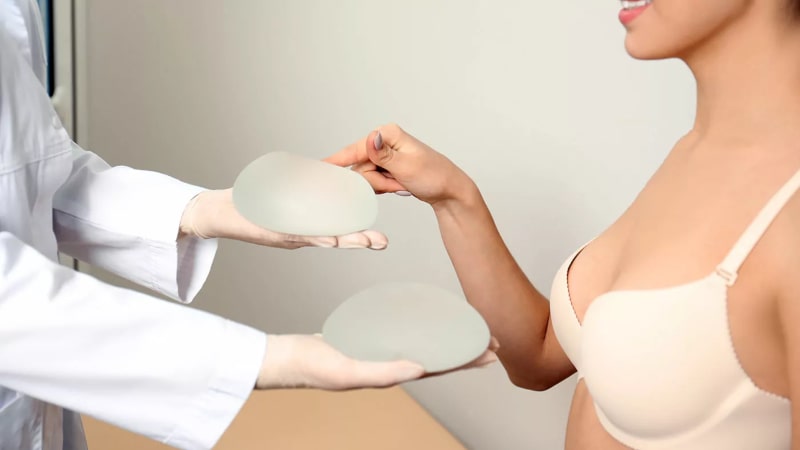Breast replacement refers to surgery to replace existing breast implants with new ones. This procedure is usually performed for a variety of reasons, such as replacing old or damaged implants, improving breast size or shape, or correcting complications related to existing implants.

Breast replacement is a personalized procedure that takes into account the specific needs and wishes of each patient. Implant size, shape and type options can be discussed with the plastic surgeon to ensure satisfactory results.
It is important to note that breast replacement is a surgical procedure with certain risks and potential complications. It is therefore essential to consult with a qualified and experienced plastic surgeon, discuss all expectations and concerns, and understand the steps of the procedure as well as the post-operative care necessary to promote successful recovery.
Table of Contents
TogglePrice Change breast prosthesis in Tunisia
The price of breast replacement in Tunisia may vary depending on several factors, such as the complexity of the procedure, the type of implant used, the surgeon’s fees and hospitalization costs. It is recommended to consult a qualified and experienced plastic surgeon in Tunisia for a personalized quote.
Breast prosthesis replacement: For whom?
Breast replacement is generally recommended for women who have already had breast augmentation with implants and wish to change the size, shape or type of implant. It may also be recommended in the case of complications related to existing implants, such as rupture, capsular contracture or change of implant position.
When to change breast implants?
There is no set period for breast implant replacement because the lifetime of implants can vary from person to person. However, it is recommended that you visit your plastic surgeon regularly to assess the condition of the implants and discuss the possibility of replacement.
Why remove breast implants?
There may be several reasons why a woman may consider having her breast implants removed. Some women may decide to remove their implants for personal, aesthetic or medical reasons. For example, they may wish to return to their natural appearance or they may experience complications related to existing implants such as rupture, leakage, capsular contracture or discomfort.
What is the life span of a breast implant?
The lifespan of breast implants varies depending on the type of implant used and individual factors. Breast implants generally have an average lifespan of 10 to 15 years. However, it is important to note that even if the implants do not show signs of failure, it is recommended that you visit your plastic surgeon regularly to assess their condition and discuss the possibility of replacement.
Breast Replacement: The actual procedure
Breast replacement can be performed using different surgical techniques, depending on the patient’s needs and preferences, as well as the recommendations of the plastic surgeon. The three main techniques commonly used are areola, breast fold and incision in the armpit.
Through the areola:
This technique, also called periareolar, involves making an incision along the lower edge of the areola, the pigmented area around the nipple. This approach allows scars to be well hidden, as they blend naturally into the contour of the areola. It is often used when adjustments to the size or position of the areola are needed, in addition to implant replacement.
By the breast fold:
This technique, known as the inframammary incision, involves an incision along the natural fold below the breast. This approach provides good surgical visibility and direct access to the implant area. Scars are usually well hidden in the under-breast fold, making the results aesthetically pleasing.
Through an incision in the armpit:
This technique, called a trans-axillary incision, involves an incision in the armpit. This allows the breast implants to be placed without creating visible scars on the breast itself. However, this approach may be more complex and requires specific surgical expertise.
Surgical follow-up after a breast prosthesis change
The surgical outcomes after a breast replacement may vary from patient to patient, but it is important to prepare for some common steps and take the necessary measures for optimal recovery.
After surgery, it is common to feel some pain, swelling and bruising in the breasts. Your surgeon may prescribe analgesics to relieve discomfort and recommend cold compresses to reduce swelling.
It is important to follow the post-operative instructions provided by your surgeon to promote rapid recovery and reduce the risk of complications. This may include recommendations for incision care, wearing a compression bra, taking antibiotics to prevent infection, and limiting physical activity during recovery.
It is essential to schedule regular follow-up visits with your surgeon to monitor the healing and ensure that the implants stabilize properly. Your surgeon will also provide you with guidance on resuming daily and physical activities, including returning to work, exercising and wearing the appropriate bra.
The recovery period may vary, but most patients can resume normal activities within a few weeks of surgery. However, it is important to note that each person recovers at their own pace, and it is crucial to listen to your body and not rush the healing process.
If you notice unusual symptoms such as fever, severe pain, excessive bleeding or significant changes in the appearance of your breasts, it is important to contact your surgeon immediately.
By following your surgeon’s instructions and taking care of yourself during the recovery period, you can maximize the chances of successful healing and achieving the desired results of your breast prosthesis change.
Result of a breast prosthesis change in Tunisia
The outcome of a breast prosthesis change depends on several factors, including the patient’s aesthetic goals, the expertise of the cosmetic surgeon and the surgical technique used. In general, the goal of the intervention is to improve breast size, shape and symmetry while creating a natural and harmonious appearance.
The final results may take time to show because the healing and adjustment process of breast tissue can take several weeks or even months. As the swelling decreases and the tissues stabilize, the breasts will take their final shape.
It is important to note that each patient is unique and the results may vary depending on their anatomical characteristics, quality of breast tissue, surgical technique used and individual response to surgery. Clear and open communication with the plastic surgeon prior to surgery is essential to ensure that patient expectations are aligned with realistic outcomes.
Overall, a well-performed breast replacement in Tunisia can give satisfactory results, with larger breasts, better proportioned and more aesthetic. Patients may benefit from increased self-confidence and improved body image. It is important to follow the surgeon’s post-operative recommendations, maintain a healthy lifestyle and consult regularly for follow-up visits in order to maintain long-term results.
Risks of breast replacement
Breast replacement, like any surgery, has certain risks and potential complications. It is essential that patients be fully informed of these risks before deciding to proceed with the procedure. Some of the possible risks associated with changing breast implants include:
- Infection: There is a risk of infection after surgery. However, this risk is generally low due to strict asepsis and hygiene protocols followed by surgeons and medical staff.
- Hematoma: A hematoma, which is an accumulation of blood inside the breast, can occur after surgery. This may require additional drainage to drain the accumulated blood.
- Capsular shell: In some cases, a fibrous scar may form around the breast implant, causing a feeling of stiffness and deformation of the breast. In rare cases, this may require additional intervention to correct the situation.
- Implant rupture: Although modern breast implants are designed to be durable, there is still a low risk of rupture. If an implant breaks, it should be removed or replaced surgically.
- Changes in sensitivity: After the procedure, some patients may experience changes in sensitivity in their breasts or nipples. These changes may be temporary or permanent.
- Healing problems: Some patients may have healing problems, including hypertrophic or keloid scars, which may require additional treatment.
It is important to note that these risks are generally rare and that the majority of patients successfully undergo a breast prosthesis change without major complications. However, it is essential to choose an experienced and qualified plastic surgeon, as well as follow all post-operative instructions to minimize the risks and maximize the chances of obtaining safe and satisfactory results. Open and honest communication with the plastic surgeon is also essential to assess individual risks and make an informed decision.








